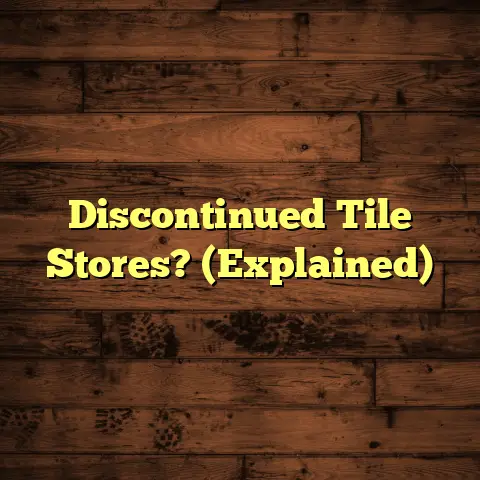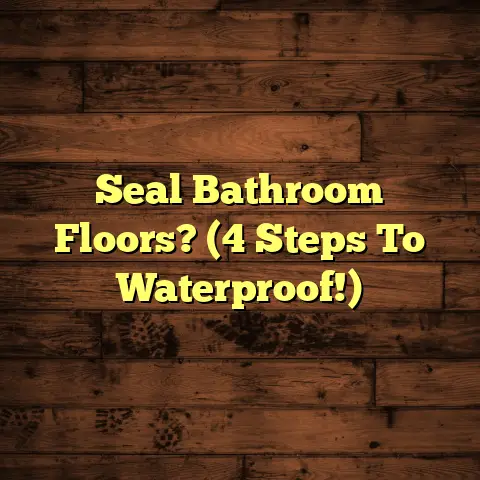Water to Ruin Hardwood? (3 Drops a Disaster?)
We live in a world where sustainability is no longer a buzzword; it’s a necessity. We’re all trying to make eco-conscious choices, from the food we eat to the materials we use in our homes. Hardwood flooring, when sourced responsibly, is a fantastic option. It’s beautiful, durable, and can last for generations. But can a few drops of water really spell disaster for this beloved flooring material? Buckle up, let’s find out!
Section 1: Understanding Hardwood Flooring
So, what exactly is hardwood flooring? Simply put, it’s flooring made from wood harvested from deciduous trees – trees that lose their leaves annually. Think oak, maple, cherry, walnut, and hickory.
Each species has its own unique grain pattern, color variation, and hardness. Oak, for example, is a classic choice known for its durability and versatility. Maple offers a cleaner, more modern look. Cherry boasts a rich, reddish hue.
But it’s not just about aesthetics. The way hardwood is harvested and manufactured plays a huge role in its sustainability. Look for certifications like the Forest Stewardship Council (FSC). This ensures the wood comes from responsibly managed forests. These forests are replanted and biodiversity is maintained.
The beauty of hardwood goes beyond its appearance. It’s a natural, renewable resource that can last for decades with proper care. It adds value to your home, provides a warm and inviting atmosphere, and contributes to a healthier indoor environment. It’s a win-win-win!
Section 2: The Science of Wood and Water
Now, let’s get a little nerdy and talk about the science of wood and water. Wood is a hygroscopic material, meaning it naturally absorbs and releases moisture from the air. This is why humidity plays such a big role in how your hardwood floor behaves.
Think of wood as a sponge. It has tiny cells that can fill with water. When the humidity is high, wood absorbs moisture and expands. When the humidity is low, it releases moisture and contracts. This is what we call “wood movement.”
The ideal moisture content for hardwood flooring is typically between 6% and 9%. When the moisture content fluctuates outside of this range, problems can arise. Too much moisture, and the wood can swell, warp, or even rot. Not enough moisture, and the wood can shrink, crack, and become brittle.
At a molecular level, water molecules bond with the cellulose and lignin in wood. This weakens the cell walls and makes the wood more susceptible to damage. It’s like adding water to a cardboard box – it loses its strength and structure.
Section 3: Common Causes of Water Damage
Okay, so we know that water and hardwood aren’t the best of friends. But how does water actually get to your floor? Let’s look at some common culprits:
- Spills: This is the most obvious one. A dropped glass of water, a pet accident, or an overflowing sink can all lead to water damage.
- Leaks: Hidden leaks from plumbing, appliances, or roofs can be particularly damaging. Because they’re often undetected for long periods of time.
- High Humidity: In humid climates, the air itself can be a source of moisture. Especially if your home isn’t properly ventilated.
- Improper Cleaning: Using excessive water when mopping or cleaning your hardwood floors can saturate the wood and lead to damage.
- Flooding: Natural disasters such as floods can cause significant damage to hardwood floors, often requiring complete replacement.
Even seemingly small amounts of water can cause big problems. A few drops of water left unnoticed under a rug or near a baseboard can seep into the wood and cause discoloration, warping, or even mold growth.
I remember one time, a homeowner called me in a panic. She had spilled a small amount of water near her refrigerator. She wiped it up immediately, or so she thought. A few weeks later, she noticed a dark stain and a slight buckling in the floorboards. When I pulled up the floor, I found a significant amount of mold and rot underneath. All from a few drops of water!
Section 4: The Impact of Water Damage on Sustainability
Water damage isn’t just a cosmetic issue; it has a significant impact on the sustainability of hardwood flooring.
First and foremost, water damage often leads to the need for replacement. This means more trees need to be harvested, processed, and transported. Which increases the carbon footprint of your home.
According to the EPA, in 2018, landfills received 12.1 million tons of wood. Which is contributing to greenhouse gas emissions as it decomposes (EPA, 2018). Replacing water-damaged hardwood adds to this waste stream.
The economic implications are also substantial. Repairing or replacing water-damaged hardwood can be expensive. The average cost to repair water-damaged hardwood floors can range from \$500 to \$5,000, depending on the extent of the damage (HomeAdvisor, 2023).
Insurance claims can be complicated and may not cover all the costs. In addition, water damage can decrease the value of your home.
But the broader environmental consequences are perhaps the most concerning. The manufacturing of new hardwood requires energy, water, and chemicals. All of which contribute to pollution and resource depletion.
Choosing sustainable flooring options and taking steps to prevent water damage is crucial for minimizing your environmental impact.
Section 5: Signs of Water Damage in Hardwood Floors
The key to preventing major water damage is early detection. Here are some signs to look out for:
- Discoloration: Dark stains, white spots, or a general dulling of the finish can indicate water damage.
- Warping: Floorboards that are cupped (edges higher than the center) or crowned (center higher than the edges) are a sign of moisture imbalance.
- Buckling: This is when the floorboards lift up from the subfloor, creating a wavy or uneven surface.
- Swelling: Noticeable expansion of the floorboards, especially around the edges, can indicate water absorption.
- Mold or Mildew: A musty odor or visible mold growth is a clear sign of water damage.
- Changes in Texture: The floor may feel soft, spongy, or uneven to the touch.
Regular maintenance is also essential. Sweep or vacuum your floors regularly to remove dirt and debris. Use a damp mop with a pH-neutral cleaner specifically designed for hardwood floors. Avoid using excessive water or harsh chemicals.
I always tell my clients to be proactive. Check your plumbing regularly for leaks. Ensure proper ventilation in bathrooms and kitchens. And address any spills immediately.
Section 6: Case Studies and Real-Life Examples
Let’s take a look at some real-life examples of how water damage can impact hardwood floors.
Case Study 1: The Hidden Leak
A homeowner noticed a slight discoloration near her dishwasher. She initially dismissed it as a minor stain. However, over time, the discoloration worsened. The floorboards began to cup. When she called me in, I discovered a slow, hidden leak from the dishwasher supply line. The leak had been seeping into the subfloor for months, causing extensive damage. The entire kitchen floor had to be replaced.
Case Study 2: The Humid Climate
A homeowner in a coastal area struggled with high humidity levels in his home. Despite running a dehumidifier, he noticed his hardwood floors were constantly expanding and contracting. This caused the finish to crack and peel. He eventually had to install a moisture barrier under the flooring and upgrade his ventilation system to control the humidity.
Expert Opinion:
“Water damage is one of the most common issues we see with hardwood floors,” says Sarah Johnson, a restoration specialist at [Restoration Company Name]. “Early detection and prompt action are crucial. The longer water sits on the floor, the more damage it will cause. In severe cases, mold growth can pose a health hazard.”
Section 7: Long-Term Solutions for Protecting Hardwood
So, what can you do to protect your hardwood floors from water damage? Here are some long-term solutions:
- Proper Installation: Ensure your hardwood floors are installed correctly with a moisture barrier underneath.
- Regular Maintenance: Sweep, vacuum, and damp-mop your floors regularly. Use a pH-neutral cleaner designed for hardwood floors.
- Environmental Controls: Maintain a consistent humidity level in your home, ideally between 30% and 50%. Use a dehumidifier in humid climates and a humidifier in dry climates.
- Prompt Spill Response: Clean up spills immediately with a dry cloth.
- Leak Detection: Check your plumbing, appliances, and roof regularly for leaks.
- Water-Resistant Finishes: Consider using a water-resistant finish on your hardwood floors, especially in high-moisture areas like bathrooms and kitchens.
- Engineered Hardwood: Engineered hardwood is more resistant to moisture than solid hardwood. This is because of its multi-layered construction. The core layers are designed to resist warping and swelling.
- Innovative Technologies: Some companies are developing new technologies to enhance the water resistance of hardwood flooring. Such as nano-coatings and wood stabilization processes.
I’ve seen some incredible advancements in flooring technology. Some of these advancements can make hardwood more resilient than ever before. These innovations can help maintain both aesthetics and sustainability.
Conclusion
So, can just a few drops of water ruin your hardwood floor? The answer, unfortunately, is yes. Even small amounts of water can cause significant damage over time.
Understanding the delicate relationship between hardwood and water is crucial for maintaining the longevity and sustainability of your flooring. By taking preventative measures, addressing spills promptly, and maintaining a consistent humidity level in your home, you can protect your investment and ensure your hardwood floors remain beautiful and eco-friendly for years to come.
As homeowners, we have a responsibility to care for our flooring choices. By doing so, we can ensure they remain both eco-friendly and beautiful for generations to come. It’s not just about aesthetics; it’s about making sustainable choices that benefit our planet and our homes. Now, go forth and protect those floors!
References:
- Environmental Protection Agency (EPA). (2018). Advancing Sustainable Materials Management: 2018 Fact Sheet. https://www.epa.gov/facts-and-figures-about-materials-waste-and-recycling/advancing-sustainable-materials-management
- HomeAdvisor. (2023). How Much Does Water Damage Restoration Cost? https://www.homeadvisor.com/cost/disaster-recovery/repair-water-damage/





